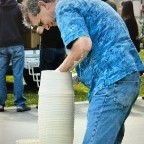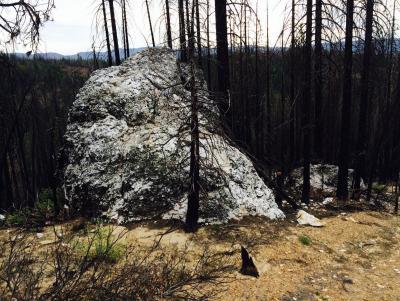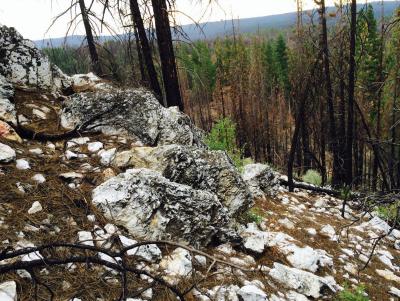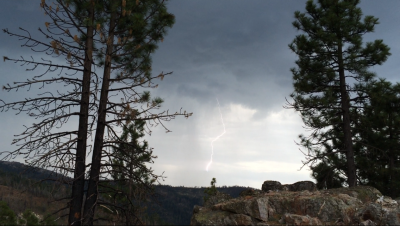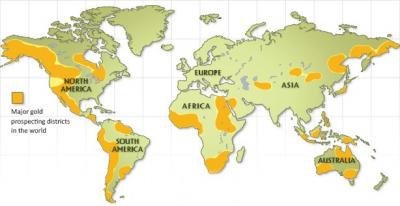Search the Community
Showing results for tags 'geology'.
-
A mining company called Integra is offering a $1 million prize to process their 6 terabytes of data and make a new big gold discovery in a hard rock property they purchased in Canada. https://herox.com/IntegraGoldRush If anyone is into mapping, exploration, geology, hard rock mining, and data processing with computers then this may be something you are interested in. We're obviously all interested in gold already! Seems like there are a few mining engineers and geologists that post on various gold forums.
-
Steve, Can you explain why Tailing piles are lower in mineralization compare to other areas, And would the Tailings at place's like Moore's Creek be Hotter than The Tailings Ganes Creek, What Cause's them to be Lower than the general Detecting Areas is it Because they are made up of disturbed Ground?? Thanks,,, John
-
Spent a few hours detecting and exploring the hillsides yesterday. I first turned on the Zed about 7:30 in the morning, it was semi overcast warm and a little humid. I was detecting a huge quartz outcrop on the edge of a minor slightly eroded peak inside a series of small ravines, the solid quartz mass was 15 feet high in areas and littered the slopes, there were many such breakouts in the area, fire a few years back cleared the brush and the hills were still easy to navigate. Also a history of tunnels and hydraulicing near-by, although these hillsides were spared of that. The weather was very variable and the chatter was slowly building in the zed although I never felt it was making it impossible to read the signals, the bursts were far enough apart to tell the difference. The trash I found was all very old stuff, no gold this trip as the weather cut things short and things were nearing the dangerous side. Possibly no gold in this outcrop that may be why no washing of the hill by the old timers, or the bedrock may be to deep also the slopes are very steep here, then again it may just be that more time needs to be spent looking.
-
The state of wy is doing a pine tree clear-cut over top of a potential gold rich zone north of the old miners delight mine, doing so in the name of better habitat for the quakies. This seems a little wierd to me, so i ask if anyone knows if removal of decidous? trees would greatly increase effectivness of such a survey?
-
Hello all, I got out today with one of my friends and we went exploring. We were moving up a wide draw that had water running in it and came up on an inside turn where we found evidence that someone had been playing around recently. There was a black plastic gold pan lying near the creek by some cleaned out cracks. We had not found any gold yet so we decided to stop for a bit and see what was in the area. Chris used his small pick and scraped out a few shallow cracks that had moss covering them. He then panned the material out to see several pin point bits of gold. The area was worked all around by the old timers but I am pretty sure the fine gold is what they were recovering. I continued to detect near the water's edge and finally got a soft signal on the bedrock, but It turned out to be a tiny piece of lead. While on my knees and looking at the bedrock in front of me I saw what I thought was a boot track in the bedrock. In the split second that my mind was telling me one thing I was thinking another. This is pretty hard bedrock and there should be no print. Looking again I realized that was looking at fossilized ground. Checking closer I could see lots of prints embedded in the rock. I don't know what many of them are but it sure was neat seeing them like that. After playing around and taking some pictures we decided to move on and see if we could find a piece of gold a bit larger than what was in the pan. As we were going up the public side of the draw I spied a digging up the hill on the private side. We checked out our location on the phone and have it earmarked for a possible trip in the future if we can gain permission from the owner. We were real close, however without permission it was a no go for me. I would appreciate any information that anyone can offer as to what the names are for some of these creatures we found in the rock. Thanks, TRINITYAU/RAYMILLS TRINITYAU.COM
-
Just was wondering why so many desert prospectors find good gold in red dirt/rusty quartz? Especially in Australia and Arizona deserts? I know the red is iron but whats that have to do with gold? I am sure not all reddish/orange dirt has gold so are there tricks you guys use besides just detecting and sampling to find the good gold bearing red dirt? In Indiana we look for bluish clay layers along the creeks/under rocks which can have gold bits resting on top of them, a false bedrock I guess. -Tom V.
-
I recently upgraded to a minelab pi and cannot wait to take it out. I've been looking at a few places that are up around 7000 feet in elevation. Typically what I have read about peoples detecting tips seemed to be more focused in the lowlands. Does anybody have any tips to successfully detect at high elevations? Anything I should be doing differently or looking for? Any response is much appreciated and hopefully a few of you who work the high Sierra will see this post. Thanks
-
How bad is the mineralization in the California Gold Country region? I cannot seem to find much information on it, but lots on the Arizona desert region. Should I interpret this as mostly VLF territory or just a lack of postings about it? I've been considering the ATX for the PI capabilities but if that area can be handled by a good VLF (GB2/V3i/ATGold) that may be preferable. Priorities for me: 1) Waterproof (I used to scuba so it may see submerged use) 2) Small-ish nugget detecting in California (primary reason for getting a detector in the first place.) 3) Surf detecting (again, see #1 just for peace of mind =) #1 is the killer - really the only other option there is a 3030 (VLF). Things like the ATGold aren't recommended for the surf and the GB2 isn't waterproof. (I used to scuba and am looking at mask+snorkel as well.) It really sounds like it's right up the ATX alley but I'm open to other suggestions. I wish Minelab would hurry up with the SDC2300 - not much info on it out there right now! I don't really want to run 2-3 separate detectors but ... /shrug. Might have to, but I'd strongly prefer to just learn one machine really really well (for now.)
-
For an interesting read on pocket hunting posted on a Canadian forum- http://gpex.ca/smf/index.php?topic=12499.0
-
Hello Cy, it is very difficult to try and narrow things down for you. The problem in trying to discuss pockets or lines is that they show up differently at different locales. I can tell you what to look for here at my location but it may be completely different where you are at. We both may have opposing geology while we may also have some similar features. When I take a person out training I try and show them what is happening on the ground. The geology of your local area may be different but the set-up in my mind is probably pretty similar anywhere. Let me try a different approach. Lots of people are on the lookout for a contact zone. This is good but too many people read too much into it. Some will see a quartz stringer running across the surface and call it a contact zone. While this may be true to an extent there is bit more to it. The area that I am located at has a general push from the NW to the SE. This push is the general direction in which the most prevalent base material is heading. In my neck of the woods this is shale, any color shale. So, as I am walking along I am watching the ground near and afar and seeing that common trend from NW to SE. While walking I notice that there is a dike or a seam, whatever you want to call it, of a different material crossing or cutting the general trend of shale that I have been looking at. This different material can be three feet wide or thee inches wide or it can be tiny seams that are matchbook wide, does not really matter. Here in my area it is usually Granite, Diorite, or Quartz and I have even seen shale crosscutting shale. As I stated earlier what you are watching for is the odd body of material that is cutting your general trending material. Once I have come across a location like this I slow down and try to find its limits. At times an area can be very small and precise while at other times the area could be very large, literally square acres. Let me break down (limits). When you have one material crossing another, let's say shale being crossed by diorite, most times you will have a change in the color of the immediate and surrounding area. I try to line this area out so I can determine the likely erosion path. Remember, what is the down side of a hill now might have been just opposite millions of years ago. Finding these limits can be very frustrating when you are in an area that has lots of grass and foilage. Sometimes you will have outcroppings of the crossing material and this can really help to identify a direction. This may sound way out there, but there are many types of vegetation that grow only in certain ground conditions. This too can be a possible lead to a location. Once determined what direction that erosion has taken place I start to detect. If I am on a slope I go down the hillside several hundred feet and then start back up detecting as I go. I like to zig zag across the slope until I come across that first piece. At that point I start to concentrate on that area and up the hill. Yes, there are times that I do not get a piece and I may have to change my hunt tactics and become a little more intense with my search efforts. Of course there are times that all the pieces of the puzzle come together and there still just is no gold to be found. This happened to me a lot when I first started detecting for pockets. After a few years things became clearer and began to go my way. Once on a line/pocket you can almost run it out with a compass. I am talking about a sometimes straight line that will throw detectable gold on the surface accompanied by a clay or ironstone seam. These lines or pockets occur around the contacts that I have mentioned and can be traced for miles. An interesting scenario that I encounter in my area is that a lot of the most productive areas that I have located seem to always show up on the southeast facing slopes. So much so that I tend to seek out just those slopes. Many people are too engrossed in looking for the quartz on the surface. In my local area there is virtually no quartz at many of the locations where pockets or lines have been found. This brings me to another point. When I say pockets most people are thinking of a single location where gold has been trapped and found, such as a crevice in bedrock. Others are thinking of an enriched zone of a vein that has pocketed out and left goodies behind. What I am after when I say pockets are these lines or very small areas that run immediately below the mentioned contacts. Are they worth it ? I think they are and many of my friends have learned over the years to become "one with the dirt", and the gold starts to show up. I will say that this may just be an anomaly to the Redding,Ca area but I know that is not true. I have done the same thing in other parts of California, Nevada and Oregon. It is not easy and it can be really frustrating but it has been very rewarding for me over the years. This is a different type of hunting. I do hunt the old diggings, ground sluice operations, gullies and creeks, hardrock deposits and any other locations that the old timers worked but I like the thrill of finding gold in places where no one is looking. I hope this helps some, these are my thoughts from thousands of hours on the ground that I have hunted for pockets and lines. TRINITYAU/RAYMILLS



